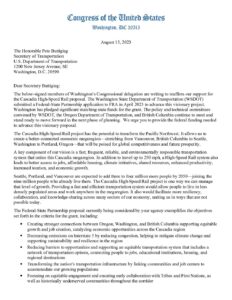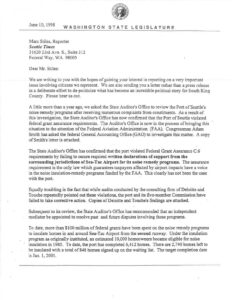 When this Washington Democratic Delegation proposal for funding a West Coast Bullet Train showed up, I immediately thought of how unreliable it has been to take AmTrak to Vancouver, BC over the past three decades. But for my family that was OK, because for us, it was strictly for pleasure. However, it was also fairly routine to have BNSF outages all along the coast. My wife once remarked, “They build highways that don’t have landslides. Why can’t they do that with rail?”
When this Washington Democratic Delegation proposal for funding a West Coast Bullet Train showed up, I immediately thought of how unreliable it has been to take AmTrak to Vancouver, BC over the past three decades. But for my family that was OK, because for us, it was strictly for pleasure. However, it was also fairly routine to have BNSF outages all along the coast. My wife once remarked, “They build highways that don’t have landslides. Why can’t they do that with rail?”
To a certain extent, passenger rail has always been a Holy Grail for a certain kind of American airport community activist; often the kind that thinks Sweden might be a great place to live–and not just for the rail. But having grown up in the EU, it has always felt to me as if American passenger rail was trying to make some ‘statement’ rather than actually performing a mission critical activity.
Aviation is mission critical here. Roads are mission critical here. You may complain about long delays at the airport or on your drive home from work, but full-on network outages that are common in passenger rail simply do not happen in those other domains. (That’s how you can tell they are mission-critical.)
Are you serious?
At the moment, one cannot measure how seriously any government takes a policy by the amount of money we spend on it. Some policies are horribly expensive and work well, and some are horribly expensive and do not.
And that is what makes it tough to support spending $200MM on planning for one rail line. Seriously? For one rail line?
What does rail have to do with Port Packages?
 I want to make a perhaps jarring pivot here to Minnie Brasher, a hero of ours we often mention, because more than almost anything, airport activists need heroes–people who did not just try but actually accomplished something.
I want to make a perhaps jarring pivot here to Minnie Brasher, a hero of ours we often mention, because more than almost anything, airport activists need heroes–people who did not just try but actually accomplished something.
Ms. Brasher was a founding member of two of the main groups fighting the Third Runway. She correctly identified problems with Port Packages decades ago. She got the State and Port to do an audit of the Port Package program which concluded that the initial round of over 1,100 systems were done poorly and needed to be re-done. It is only a slight-oversimplification to say that nobody had been inspecting the work. Not the Port. Not the Cities.
Today, we struggle to convince decision makers that just because the FAA spent $300 million on crap systems doesn’t mean that sound insulation systems are a bad idea. It just means that the program was run an awful lot like American passenger rail.

In fact, Port Packages could have been done well, and for the same money. But doing them well wasn’t really the point. The point was to do something in order to obtain permission to build the Third Runway. The Third Runway was the mission-critical task. How do we know it mission-critical? Because the Port was willing to go 400% over initial budget estimates in order to get ‘er done.
But when the discussion comes up on repairing all the thousands of Port Packages that were done poorly, the only thing decision makers mention is the cost.
‘We’ spent $300MM on Port Packages!
As if the dollar amount is some badge of honor, when in fact, it was a management failure that should have prompted all stakeholders to actually fix the problem.
Spending better
The conclusion we’ve come to is that spending on rail, at least in King County has gone a lot like Port Packages. When it’s a few hundred million, perhaps you can get away with wasting public money on an ill-conceived ‘bullet train’ (or several thousand crap Port Packages.) But if you do, good luck when it comes time to ask for that nine figure spend.
It doesn’t seem to occur to people that the goal must be to execute flawlessly.
So much mistrust has developed over our inability to execute on any form of public spending that it is difficult to imagine obtaining funding for the real spend (ie. the $50-100BB to actually build this one rail line.)
Follow the incentives
Again, the proposal is not an actual route that can be evaluated. But as with Port Packages (or any other large project) it already has powerful incentives, including not only desperation over climate and aviation capacity, but mainly: jobs, Jobs, JOBS! This insatiable desire to put people to work at some of the last well-paid blue collar jobs could be a stronger driver than addressing the problem the project is meant to solve. So even if you can get the funding to build a real line, the likelihood of gotchas becomes so significant that the only real winners end up being the construction crews. Sound familiar?
The 25 Year Shiny Penny Trick
And there is one other, truly insidious incentive. For airport communities, this could be just another shiny penny trick, like Sustainable Aviation Fuel, electric aviation and the entire Second Airport discussion–an empty promise concerning something twenty five years in the future, which only enables going full throttle at Sea-Tac airport now.
Build back better?
As usual, we have a mixed message. But truly it can be summed up in one word: sincerity.
In principle, we support rail. Obviously. But if it did not happen fifty years ago, when it was an order of magnitude more ‘doable’, it seems to us that the pressure to do it right should be front and center in the discussion.
So, it would have been nice if that letter had acknowledged that not only must we spend money on infrastructure, we must do it better than we have done in the past several decades. We must demonstrate that we understand the stakes involved and prove that we can do rail properly. If we don’t. we will never get an opportunity to do enough of it to matter.
Because again, one reason it’s so tough to convince both the public and decision makers of the value of sound insulation is the fact that when we had a chances to deploy it at scale we did not do it well.
And the same goes double for rail. Every project goes so far over budget and seems to have so many basic management challenges it creates a vicious circle of cynicism: It costs a fortune, we don’t execute well, so why bother?
We are not so arrogant as to suggest what management steps are needed to make this project go better than previous rail projects. Only that we must demonstrate that we have the will to (literally) build back better. This is not just a test; it’s the test.
So we have to small demands:
- Acknowledge past mistakes in passenger rail and transporation planning. Reassure all stakeholders that this time it will be ‘mission critical’.
- Acknowledge that any grand vision will take twenty five years and thus should also include compensation for airport communities. We’re the people who will continue to take it in the neck, whether it’s legit or not.